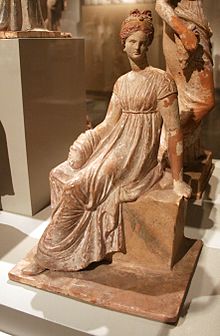
Salamis was an ancient Greek city-state on the east coast of Cyprus, at the mouth of the river Pedieos, 6 km north of modern Famagusta. According to tradition, the founder of Salamis was Teucer, son of Telamon, king of the Greek island of Salamis, who could not return home after the Trojan War because he had failed to avenge his brother Ajax.

Terracotta, also known as terra cotta or terra-cotta, is a clay-based non-vitreous ceramic fired at relatively low temperatures. It is therefore a term used for earthenware objects of certain types, as set out below.
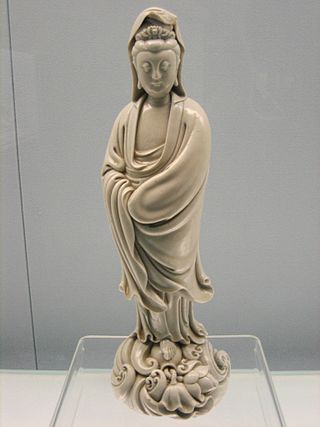
A figurine or statuette is a small, three-dimensional sculpture that represents a human, deity or animal, or, in practice, a pair or small group of them. Figurines have been made in many media, with clay, metal, wood, glass, and today plastic or resin the most significant. Ceramic figurines not made of porcelain are called terracottas in historical contexts.
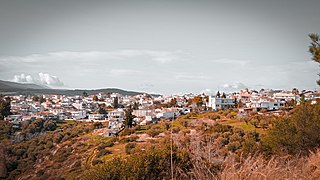
Tanagra is a town and a municipality north of Athens in Boeotia, Greece. The seat of the municipality is the town Schimatari. It is not far from Thebes, and it was noted in antiquity for the figurines named after it. The Tanagra figurines were a mass-produced, mold-cast and fired type of Greek terracotta figurine produced from the later fourth century BC, primarily in Tanagra.

The sculpture of ancient Greece is the main surviving type of fine ancient Greek art as, with the exception of painted ancient Greek pottery, almost no ancient Greek painting survives. Modern scholarship identifies three major stages in monumental sculpture in bronze and stone: the Archaic, Classical and Hellenistic. At all periods there were great numbers of Greek terracotta figurines and small sculptures in metal and other materials.

Gortyna was a town of ancient Crete which appears in the Homeric poems under the form of Γορτύν; but afterwards became usually Gortyna (Γόρτυνα). According to Stephanus of Byzantium it was originally called Larissa (Λάρισσα) and Cremnia or Kremnia (Κρήμνια).
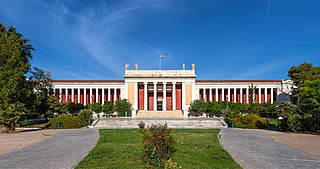
The National Archaeological Museum in Athens houses some of the most important artifacts from a variety of archaeological locations around Greece from prehistory to late antiquity. It is considered one of the greatest museums in the world and contains the richest collection of Greek Antiquity artifacts worldwide. It is situated in the Exarcheia area in central Athens between Epirus Street, Bouboulinas Street and Tositsas Street while its entrance is on the Patission Street adjacent to the historical building of the Athens Polytechnic university.

Christos Tsountas was a Greek classical archaeologist. He is considered a pioneer of Greek archaeology and has been called "the first and most eminent Greek prehistorian".
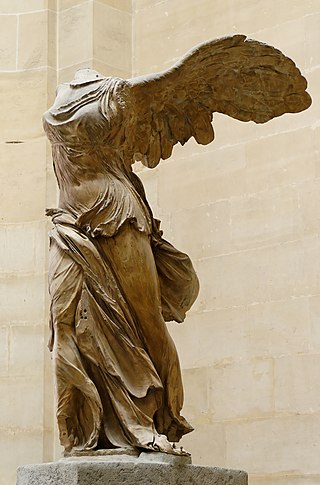
Hellenistic art is the art of the Hellenistic period generally taken to begin with the death of Alexander the Great in 323 BC and end with the conquest of the Greek world by the Romans, a process well underway by 146 BC, when the Greek mainland was taken, and essentially ending in 30 BC with the conquest of Ptolemaic Egypt following the Battle of Actium. A number of the best-known works of Greek sculpture belong to this period, including Laocoön and His Sons, Venus de Milo, and the Winged Victory of Samothrace. It follows the period of Classical Greek art, while the succeeding Greco-Roman art was very largely a continuation of Hellenistic trends.

Terracotta figurines are a wide range of small figurines made throughout the time span of Ancient Greece, and one of the main types of Ancient Greek pottery. Early figures are typically religious, modelled by hand, and often found in large numbers at religious sites, left as votive offerings. Psi and phi type figurines are two very early and simple types, dating as far back as 1400 BCE.

The Staatliche Antikensammlungen is a museum in Munich's Kunstareal holding Bavaria's collections of antiquities from Greece, Etruria and Rome, though the sculpture collection is located in the Glyptothek opposite, and works created in Bavaria are on display in a separate museum. Ancient Egypt also has its own museum.

Etruscan art was produced by the Etruscan civilization in central Italy between the 10th and 1st centuries BC. From around 750 BC it was heavily influenced by Greek art, which was imported by the Etruscans, but always retained distinct characteristics. Particularly strong in this tradition were figurative sculpture in terracotta, wall-painting and metalworking especially in bronze. Jewellery and engraved gems of high quality were produced.

The Archaeological Museum of Nafplio is a museum in the town of Nafplio of the Argolis region in Greece. It has exhibits of the Neolithic, Chalcolithic, Helladic, Mycenaean, Classical, Hellenistic and Roman periods from all over southern Argolis. The museum is situated in the central square of Nafplion. It is housed in two floors of the old Venetian barracks.

The Swedish Cyprus Expedition was assembled to systematically investigate Cyprus’s early archaeological history. The expedition occurred between September 1927 and March 1931 and was led by the three archaeologists Einar Gjerstad, Erik Sjöqvist and Alfred Westholm together with the architect John Lindros who photographed during their time in Cyprus. The excavation constitutes the foundation of modern archaeology in Cyprus. The results of the excavations revealed that the distinctive culture of early Cyprus had been created in close contact with various cultures from the Middle East and the western Mediterranean areas.
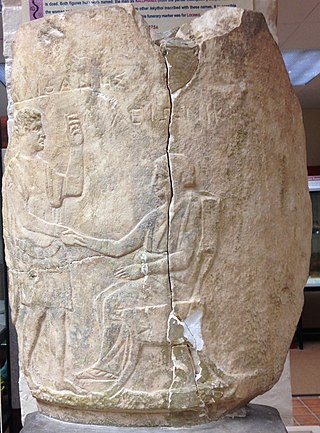
The Museum of Classical Archaeology is the teaching collection of the Department of Classics, Archaeology and Ancient History at the University of Adelaide in South Australia.

Centuripe ware, or East Sicilian polychrome ware, or the Centuripe Class of vase, is a type of polychrome Sicilian vase painting from the 3rd and 2nd centuries BC. It is rare, with only some 50 examples known. They have been described, arguably rather unjustly, as "smothered in ornamental colors and shaped too elaborately", an example of Hellenistic "Middle-class taste [that] was often cloying and hideous, sometimes appealing."

Ancient Greek art stands out among that of other ancient cultures for its development of naturalistic but idealized depictions of the human body, in which largely nude male figures were generally the focus of innovation. The rate of stylistic development between about 750 and 300 BC was remarkable by ancient standards, and in surviving works is best seen in sculpture. There were important innovations in painting, which have to be essentially reconstructed due to the lack of original survivals of quality, other than the distinct field of painted pottery.

Tanagra is a polychromic marble sculpture created by French artist Jean-Léon Gérôme (1824–1904) as a personification of the "spirit of Tanagra," his own mythic invention tied to the Tanagra figurines from the village of that name in ancient Greece. The sculpture was first shown at the Paris Salon of 1890. Gérôme subsequently created smaller, gilded bronze versions of Tanagra; several versions of the "Hoop Dancer" figurine held by Tanagra; two paintings of an imaginary ancient Tanagra workshop; and two self-portraits of himself sculpting Tanagra from a living model in his Paris atelier. These sculptures and paintings comprise a complex, self-referential artistic program in which one of the most celebrated artists of his generation explored reception of Classical antiquity, creative inspiration, doppelgängers, and female beauty.
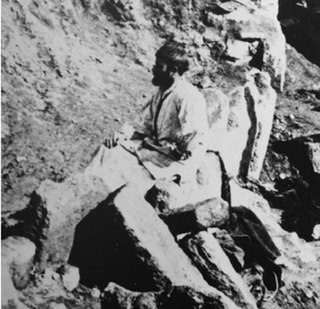
Panagiotis Antoniou Stamatakis was a Greek archaeologist. He is noted particularly for his role in supervising the excavations of Heinrich Schliemann at Mycenae in 1876, and his role in recording and preserving the archaeological remains at the site.

Athanasios Sergiou Rhousopoulos was a Greek archaeologist, antiquities dealer and university professor. He has been described as "the most important Greek collector and dealer between the 1860s and 1890s", and as "a key figure in the early days of archaeology in Greece."

